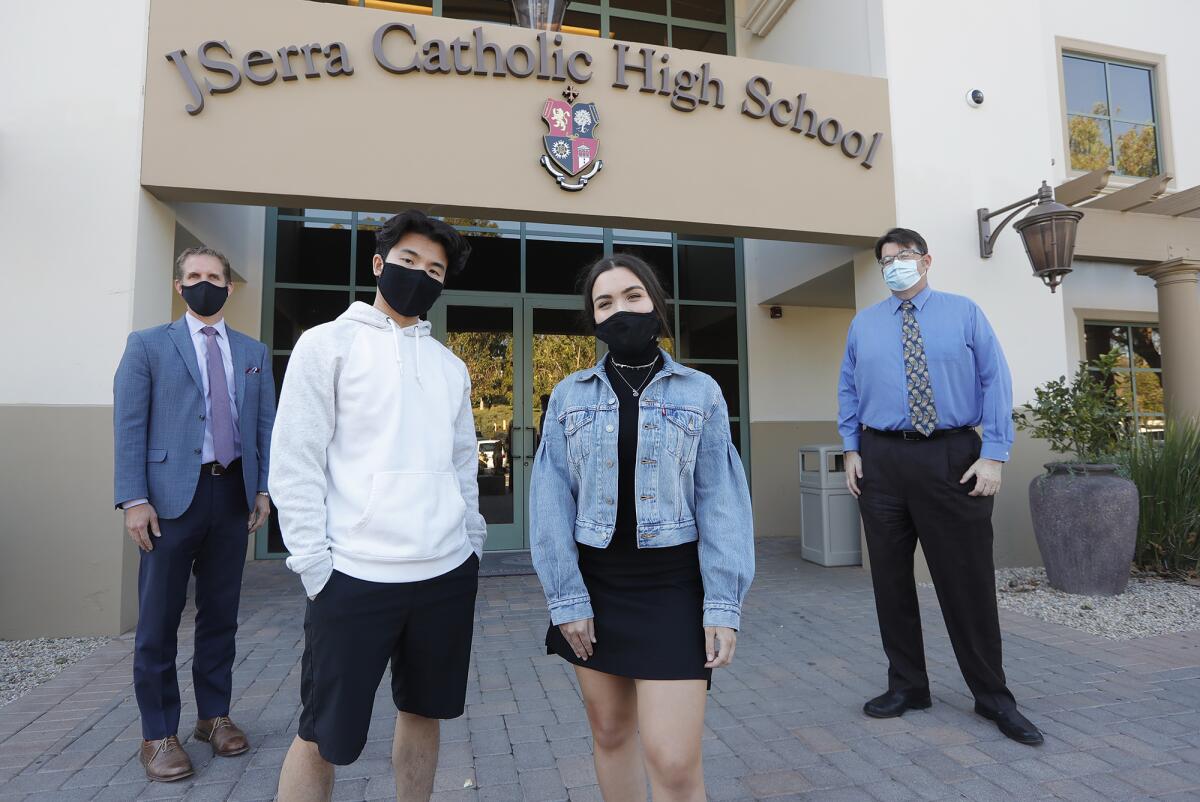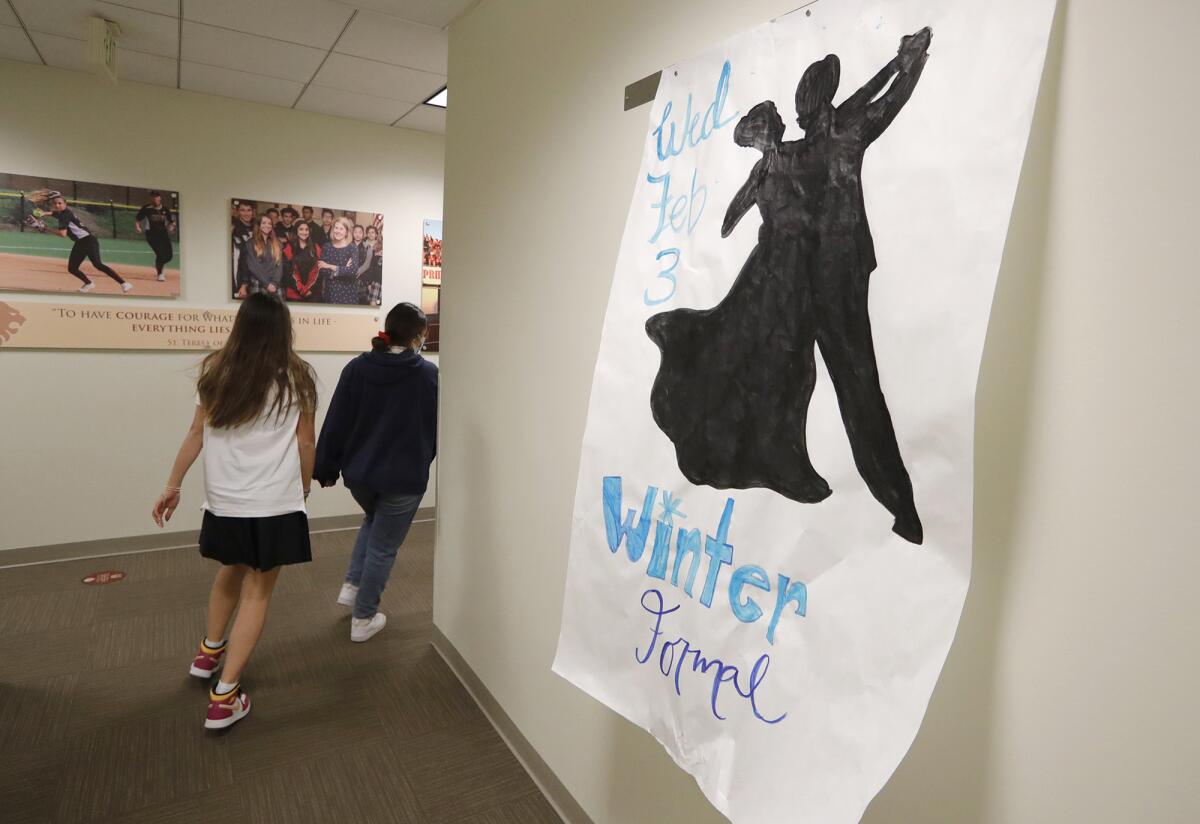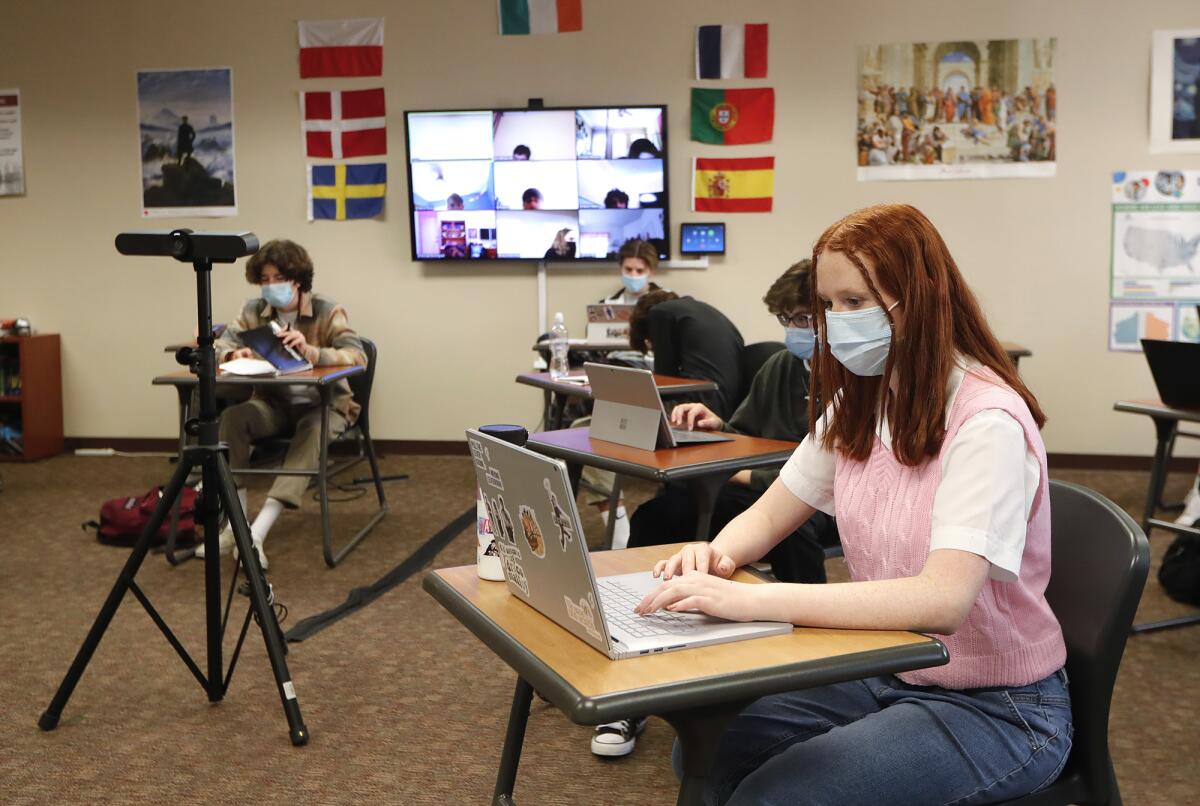JSerra, a private Catholic high school in south Orange County, went ‘bold’ in returning to school

- Share via
Last year, when JSerra Catholic High School decided to bring students back onto campus full time in the fall, it adopted a motto: “All Lions, all day.”
It was also a bold commitment. Some might have said far-fetched, given the crisis at the time.
“From the get-go, we realized kids learn better in person,” said Principal Eric Stroupe.
So, in May 2020, as the COVID-19 pandemic raged and schools were shuttered and hunkered down for the long haul, JSerra decided to buck the trend.
The 1,250-student Catholic school in San Juan Capistrano became one of few campuses in the state and the largest in Orange County to reopen in September. Officials say it has been going strong ever since.
“We didn’t become a good school because of the pandemic,” Stroupe said, “but COVID showed our heart.”
After investing $1.2 million to conform to mandated health requirements, JSerra welcomed back students.
“We felt almost a moral responsibility to return,” said President Rich Meyer, noting that without students, “the heart of a school is excised, and all you have is buildings.”
To become compliant and gain approval to open is no small feat. It required technology upgrades and innovation, reengineering of classes and common spaces and a host of protocols covering everything from entering and exiting class and eating policies to mask and distancing requirements. And cleaning, cleaning, cleaning.

Screening and tracing
In addition, all students continue to undergo health screenings and questioning every day before going on campus, and the school maintains a rigorous contact tracing and quarantining program.
Senior Ryan Horio, 18, is one of 25 student volunteers who checks in students in the morning.
“Between the students there’s pressure to call each other out,” he said. “Hey, it’s a privilege to come back to school.”
Since August, 20 JSerra students and seven staffers have been diagnosed with the coronavirus.
Administrators believe students and staff became ill from an off-campus interaction. .
“We’re only as good as the information on our tracing,” Stroupe said. “To our knowledge no transmission has occurred on campus.”
Students who have had contact with someone with COVID-19 or suffer symptoms are quarantined up to 14 days and attend classes online.
The school added about 10,000 to 15,000 square feet of extra classrooms by converting public spaces, such as the library and meeting rooms. Classrooms average 18 students. They have hospital-grade air filters and ionization units, and cleanup crews cover the campus daily. Classrooms are stocked with cleaning supplies and sanitation stations at the doors. The restrooms have touchless faucets and hand dryers.
“You can’t go 10 feet without hitting a sanitation station,” said Vice Principal Donna Vandenberg.

Keeping it ‘fun’
The transition hasn’t been perfect. Popular activities such as sports, rallies and all-school Masses were eliminated.
However, a lunchtime Winter Formal was held, complete with socially distanced dancing. The school also staged a surprise “snow day,” Feb. 5, with slides and areas where students could make snowballs and “pelt the pandemic.”
“They’ve been really good at making it fun,” Horio said. “I know my senior year looks different, but they really want to make it special for us. I have friends from other schools and they’re like, ‘Wow, you get to see your friends?’”
Gillian Chade, an 18-year-old senior from Dana Point, spent most of the first semester attending classes online before returning to campus.
“Now I’m back in person I realize how much I missed it,” she said. “Being back is just a blessing.”
Mia Contreras, a 15-year-old sophomore, said her mental health has improved.
“When I was online, I couldn’t talk to my friends at all. I felt so alone and isolated,” she said.
“I definitely do better being here than sitting in my room all day,” said Cameron Ricciardi, 16, a sophomore.

In the classroom
Students can attend school virtually, but Meyer said more than 90% of families support having their kids on campus. Teachers all have online accounts and classrooms are outfitted with 65-inch high-resolution screens and video conferencing.
On a recent school day, 16 students are arrayed across a classroom and another six on the big screen, as European history teacher Laura Kennedy lectures on the Russian Revolution.
“It’s all Bolshevik,” she says with a laugh.
A 14-year teacher at JSerra, she has seen firsthand the difference between in-school and online learning. She said the performance and test scores of students who were learning online dipped significantly but rebounded when they returned to campus
Although debates about returning and how to do it safely have erupted statewide, at JSerra, while there was discussion, in the end there was consensus. Every teacher returned to campus and staff was added.
Kennedy admitted to some trepidation that there would be virus outbreaks, but said she is much less nervous now and adds, “I believe the kids need to be here.”
Just in case, she has an extra N95 mask in her desk drawer.
Forging ahead
Bucking trends is not new for JSerra. Established in 2003, it was the first non-diocesan-founded Roman Catholic high school in the state and fourth in the country. That offers it certain freedoms not afforded to public and other Catholic schools.
Being relatively “bureaucracy free,” Meyer said, “We have the fortune of being able to be pretty nimble.”
“We’re not blazing a path per se,” Stroupe said.
But he has a message to other schools: “be bold in your thinking.”
Greg Mellen is a contributor to TimesOC.
All the latest on Orange County from Orange County.
Get our free TimesOC newsletter.
You may occasionally receive promotional content from the Daily Pilot.



